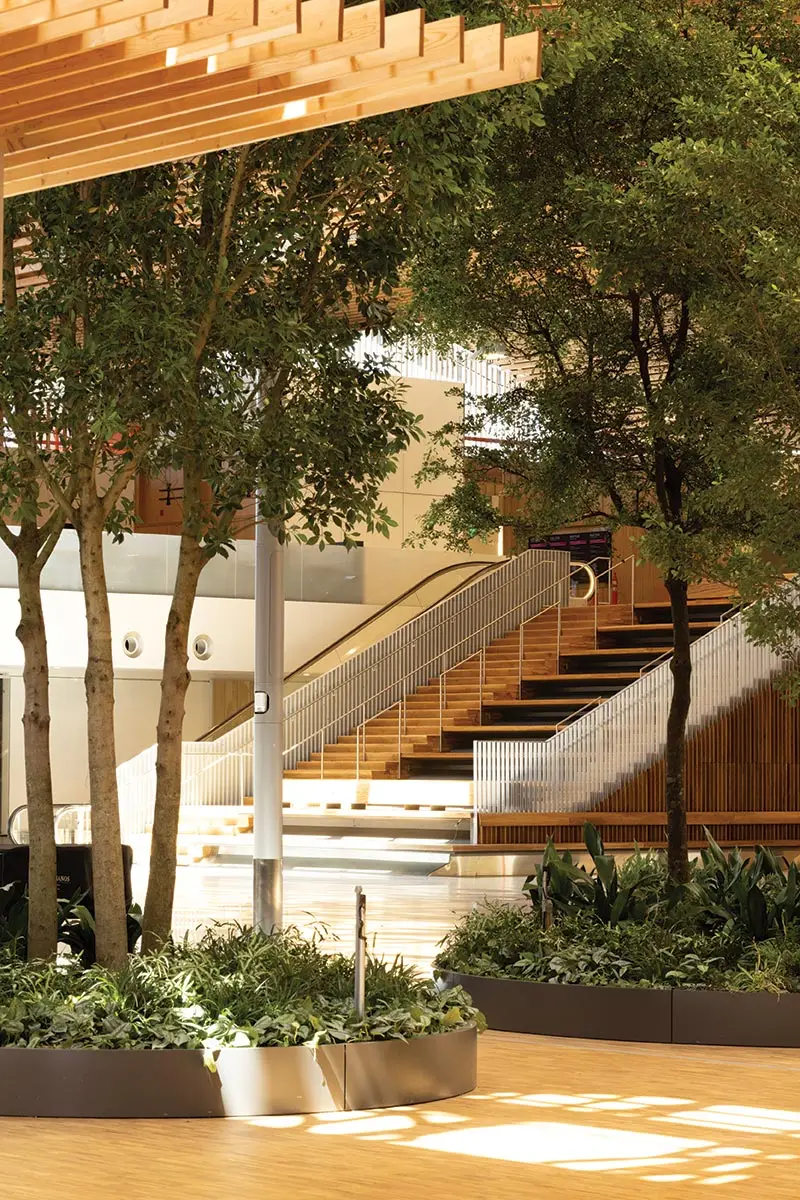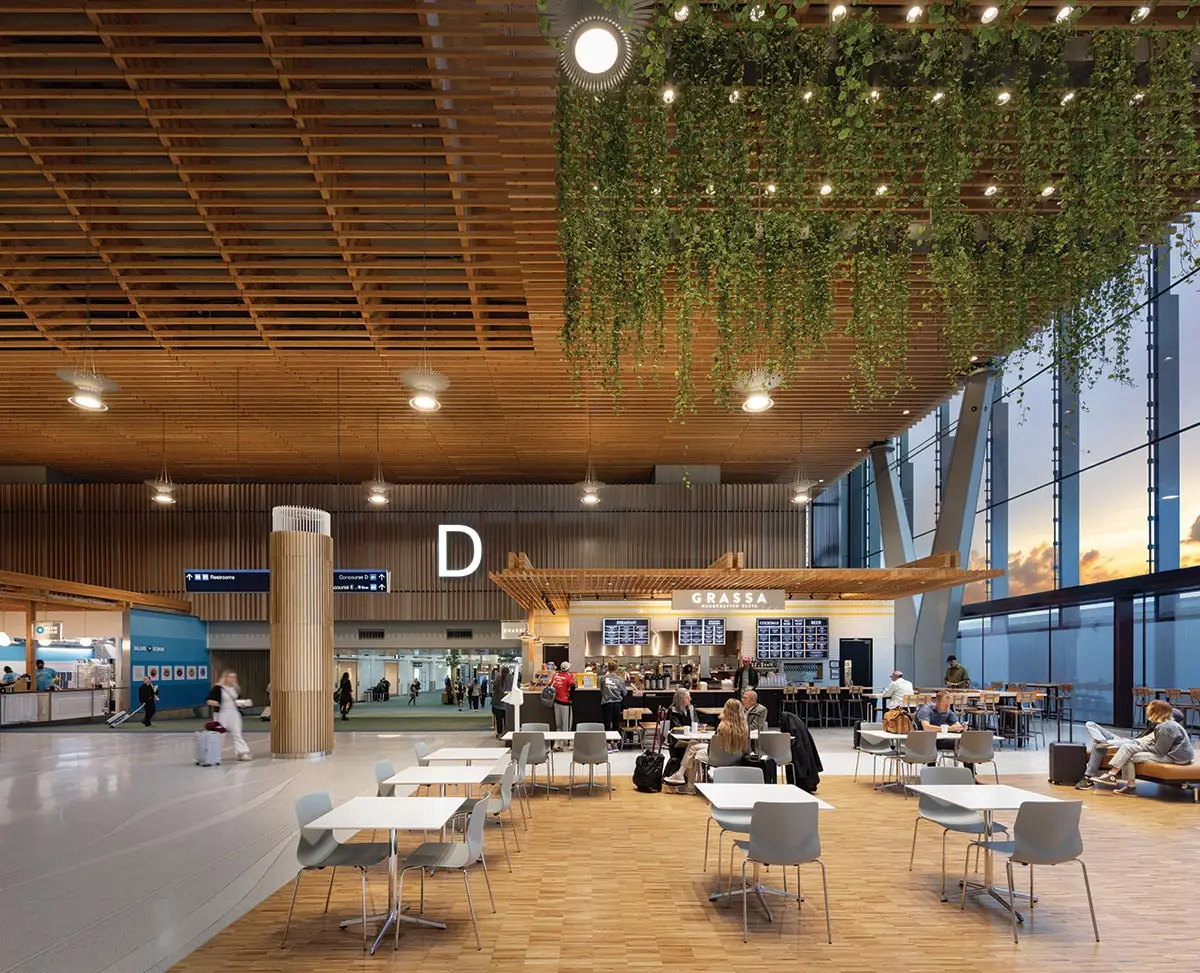Architects & Firms
“It seems like everyone is just lost in a dreamworld,” laments an outsider on the sketch comedy Portlandia. “For one thing, your airport is 20 minutes to and from. That’s not how cities are!”
The irony of the bit is that, indeed, Portland’s international airport is uncommonly easy to access, via car and public transit. The prime location is one of the reasons why those notably quirky Portlanders adore it. Outposts of local restaurants that serve food at the same price point as their downtown shopfronts (due to an anti-price-gouging policy) are another. Let’s not forget the famous carpet pattern, which has spurred apparel of all kinds. But in August, PDX opened a tree-filled main terminal, designed by local architecture firm ZGF, that sets a new, sky-high standard for air travel.

The exterior facade echoes the form of the undulant ceiling. Photo © Ema Peter, click to enlarge.
Getting to this point wasn’t a stroll through the park. Until recently, the airport had shared some less fortunate aspects with other major hubs across the country, namely, incremental expansions that aimed to keep pace with ever-accelerating demands. By 2020, PDX’s main terminal comprised 11 separate structures from different decades, all constructed on fill. “Some airports have the ability to build a terminal or an entirely new airport on the other side of the field and, one day, just turn the lights on,” says Vince Granato, chief projects officer at the Port of Portland. But, with the terminal wedged between two active runways, which are, in turn, squeezed between the Columbia River and another waterway, PDX didn’t have that luxury. Updating the agglomeration would have triggered complex (and costly) seismic upgrades without the opportunity to introduce the 21st-century fixings desired by airlines (which typically front the cost of such projects) and customers. “We’re basically at the end of a cul-de-sac,” Granato adds, “so we needed to figure out how to use the space that we already had most efficiently.”
The Port’s choice to enlist ZGF, founded in Portland but now with seven offices across North America, brought a team with intimate knowledge of the site (the firm oversaw several of the airport’s previous expansions). As ZGF partner Gene Sandoval, who led design with fellow partner Sharron van der Meulen, recalls, “Focus groups made clear that the public wanted the new terminal to reflect the region. So, we asked ourselves: ‘how can this project also drive the local economy and do it with equity?’”

Photo © Ema Peter
The firm’s answer to this question of heritage, as well as those raised by the complexities of labor costs, restrictions imposed by the Federal Aviation Administration, a need to keep the airport operational while its main terminal was deconstructed and systematically replaced, and an abundant supply of nearby lumber, came in the form of extensive prefabrication in mass timber.
Over the last four years, a 200-person team of workers fastidiously built 18 variously sized (the largest being 240 feet by 110 feet) modules, each comprising a layered system of glue-laminated arches sheathed above by mass-plywood panels and below by a lattice of dimensional lumber. In total, some 3.5 million board feet—2 million for the glulams, 850,000 for the panels, and 600,000 for the lattice—were used to build these modules—largely without the need of specialized labor, due to relative ease of connecting the components. All wood originated from within a 300-mile radius, and nonprofit Sustainable Northwest ensured that 73 percent of the roof’s timber was either FSC certified or could be traced back to family-managed businesses or tribal landowners that engaged in ecologically responsible forestry practices. The process of installing each of the modules—the three days required to lift, move, and place them—as well as the details surrounding ZGF’s comprehensive material-sourcing strategy and coordination with local mills, were described in a special section on wood construction in the June 2023 issue of RECORD.
Now open to the public, PDX’s main terminal heralds a new era of civic-scale mass-timber construction. The cool and calming scene inside couldn’t be further from the frenetic chaos many travelers must endure elsewhere—instead, it invites a certain slowness. Several planters of black olive, fern pine, and laurel fig dot the open and airy headhouse, which is capped by the prefabricated modules that together form an undulant nine-acre, 36-foot-high canopy punctuated by an array of occuli. These skylit clearings range from circular apertures to elliptical ones, where the ceiling’s delicate lattice seemingly unravels to make way for a deluge of daylight. Sandoval likens walking through the terminal to a hike in the woods, “with the same smells and light hitting the forest floor.”

1

2

3
Planters (1) and artworks (2) abound. A delicate lattice unravels at elliptical apertures, appearing to cascade (3). Photos © Ema Peter
After passing the ticketing counters, which are turned 90 degrees to create sight lines from the entrance clear through to the taxiways, travelers have the option to wander about a central two-story concession-filled “market hall,” or proceed toward the security checkpoints to the left or right—but they needn’t worry about queuing on the wrong side. PDX’s four existing gate concourses are connected, after security, via a glazed hallway that runs along the northern edge of the new terminal. In this way, the plan acts as a valve to distribute crowds during peak travel times.
Looking for a reprint of this article?
From high-res PDFs to custom plaques, order your copy today!

Freestanding concessions feature timber elements, such as slatted canopies. Photo © Ema Peter
Expansive LED-art walls—one at each checkpoint—distract travelers from time spent in line at security and conceal office and mechanical spaces. Passengers walk underneath the walls to a lower-ceilinged screening area before reemerging into another parklike space. The architects treated this stretch, the last before the airport’s gate concourses, like a sliver of Portland, quite literally. Freestanding mass-timber concessions with slatted awnings, ample movable and fixed seating, and multifunction streetlight-like fixtures that conceal cameras, speakers, lighting, and fire-safety equipment recreate the warp and weft of the city’s urban fabric. “This isn’t a typical retail gauntlet,” says Nat Slayton, one of the project architects. “We modeled it to have almost exactly the same dimensions and scale as the beloved shopping street Northwest 23rd.”

Here, at the outer edges of the new terminal, a curious detail sprouts up. Part of the curtain wall, hung from the canopy, overlaps another part, fixed to the floor, like two giant shingles. Due to the vestigial foundations underfoot, the team relocated seismic isolators to the tops of the 34 Y-shaped, grout-filled steel columns that hold up the roof assembly. In the event of an earthquake, the canopy is free to slide in any horizontal direction up to 24 inches, and the shingled overlap will facilitate movement at the envelope.
In the end, the new terminal almost doubles the footprint and volume of its predecessor without adding load to the central utility plant. “We’re using about 50 precent less energy than the old structure,” says Slayton, due to a tighter enclosure, optimized skylight placement, and a new, all-electric ground-source heat pump system. And much of that floor space remains open to the public for dining, people- and plane-watching, or waiting for arriving family or friends. “We’re bringing back some of the romance of air travel,” Sandoval says, evoking a moment when airports were destinations in and of themselves. Though two gates were lost to make space for the expansion, the airport added six more elsewhere, increasing the airport’s capacity to 35 million passengers annually and giving it plenty of room to grow from the current 16.5 million.
Though public excitement over the terminal continues to build, Granato is quick to point out the 18 or so more months of work ahead. With the new hall open, the second phase can begin, and the last few remnants of the old structure will be shuttered and disassembled. Airside, four more modules await their final home. In the meantime, locals and visitors alike can rest assured that PDX’s patterned carpet lives on in the new building. Adds Granato, “Now people can look up and see a beautiful ceiling too.”
Click plan to enlarge

Click sections to enlarge

Credits
Architect:
ZGF — Sharron van der Meulen, partner in charge; Eugene Sandoval, design partner; Patrick Boyle, project manager; Michael Adams, Hyun Chang Cho, Rick Derington, Derek deVille, Andrea Diedrich, Jacob Dunn, Janel Fausti, Mark Foster, Robert Furusho, Sara Gordon, Mark Haidle, Erin Hastings, Jonah Hawk, William Hinds, Qing Ju, Glen Justice, Nicole Lee, Nuno Lopes Regalo, Tony Martinez, Greg Matto, William McGee, Halliday Meisburger, Allison Miller, Cole Monaghan, Douglas Morris, Melissa Morton, Kevin Murney, Robin Oglesbee-Venghaus, Erkki Ojala, Robert Packard, Keenan Palmer, Cathylia Peacock, Josh Peacock, Duane Peerenboom, Zachariah Petett, Luke Ralston, Valerie Reuss, Christian Schoewe, Shahida Sharmin, Talisa Shevavesh, Makoto Shibuya, Rena Simon, Nat Slayton, Katelynn Smith, Kip Storey, Margaret Tasker, Yoshiyuki Watanabe, Phillip Wild, Wanting Zhou, design team
Engineers:
KPFF, Arup (structural); PAE, Arup (m/e/p); GRI (geotechnical); HNTB (civil)
Consultants:
TimberLab (mass timber trade partner); W&W AFCO Steel (steel trade partner); Arup (aviation planning); Sustainable Northwest (wood advisor); Place (landscape); Terrapin Bright Green (biophilic design); Fisher Marantz Stone, Luma (lighting); RWDI (air/wind analysis)
Lumber Mills:
Elk Creek Forest Products, Frank Lumber, Freres Lumber, Herbert Lumber, JayZee Lumber, Kasters Kustom Cuts, Manke Lumber, Zip-O-Log Mills
Harvest Sites:
Camp Adams, Camp Bishop, Camp Namanu, Chimacum County Park, Cow Creek Band of the Umpqua Tribe, The Nature Conservancy Central Cascades Forest, Coquille Indian Tribe, Hanschu Family Forest, Hyla Woods, Joint Base Lewis-McChord, Roslyn Urban Forest, Skokomish Indian Tribe, Willamette University Zena Forest, Yakama Nation
General Contractor:
Hoffman Skanska Joint Venture
Client:
Port of Portland
Size:
1 million square feet
Cost:
$2.15 billion
Completion Date:
August 2024
Sources
Mass Timber:
Zip-O-Laminators, Timberlab, Freres, Calvert
Stucture:
Thompson Metal Fab (Y columns); Greenberry Industrial (roof girders)
Curtain Wall:
Benson, Arcadia
Glazing:
Deamor (skylights); Carey Glass with Glas Trösch, Viracon (glass)
Interior Finishes:
Nevamar, Wilsonart, Formica (laminate); Daltile (tile); McGrory Glass, Pulp Studios (glass partitions); Zena Forest Products (wood flooring)
Furnishings:
Landscape Forms (seating); Hayworth, Vitra (chairs)
Paints and Stains:
Timber Pro








